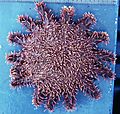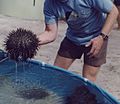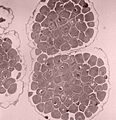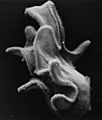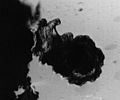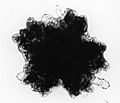Crown-of-thorns starfish facts for kids
Quick facts for kids Crown-of-thorns starfish |
|
|---|---|
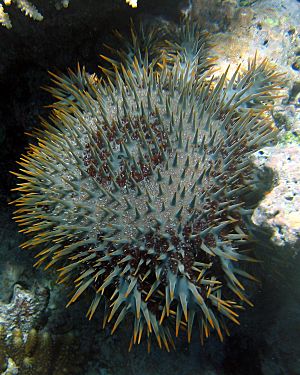 |
|
| Scientific classification | |
| Kingdom: | |
| Phylum: | |
| Class: | |
| Order: | |
| Family: |
Acanthasteridae
|
| Genus: |
Acanthaster
|
| Species: |
Acanthaster planci
|
| Binomial name | |
| Acanthaster planci (Linnaeus, 1758)
|
|
The crown-of-thorns starfish is a very large starfish with many arms. It gets its name from the sharp, venomous spines that cover its top surface, making it look like a crown of thorns. This starfish mostly eats hard corals. It is one of the biggest starfish in the world.
You can find the crown-of-thorns starfish in many parts of the Indo-Pacific ocean. This includes places like Australia, the Red Sea, the east African coast, and across the Pacific Ocean to Central America. It lives wherever there are coral reefs in these warm waters.
Contents
What Does the Crown-of-Thorns Starfish Look Like?
The crown-of-thorns starfish has a body shape similar to other starfish. However, it has some special features. Its body is disc-shaped, has many arms, and is very flexible. It is also covered in many spines.
Adult crown-of-thorns starfish usually grow to be about 25 to 35 centimeters (10 to 14 inches) wide. They can have up to 21 arms! Even though they look stiff, their bodies can bend and twist. This helps them fit around the different shapes of corals they eat. They are often dull colors like pale brown or grey-green. But in some areas, they can be very bright and colorful.
The long, sharp spines on their arms and top surface look like thorns. This is how they got their name. These spines are very stiff and sharp. They can easily poke through soft surfaces. If you take a starfish out of the water, its body might collapse. The spines will also flatten. But if it's still alive, it will get its shape back when put back in the water.
How Do Crown-of-Thorns Starfish Affect Coral Reefs?
The crown-of-thorns starfish is known for eating coral. It can cause a lot of damage, especially on the Great Barrier Reef, which is a World Heritage Site.
Normally, if there aren't too many of these starfish, they can actually help the coral reef. They do this by eating faster-growing corals. This stops those corals from taking over the whole reef. However, when there are too many crown-of-thorns starfish, they can destroy large parts of the reef.
How Do Crown-of-Thorns Starfish Behave?
Adult crown-of-thorns starfish are meat-eating predators. They mostly eat the tiny animals that make up coral, called polyps. The starfish climbs onto a living coral colony. It uses the many tube feet on its underside and its flexible body to hold on. It fits very closely to the coral's surface, even on corals with many branches.
The starfish then pushes its stomach out of its mouth and onto the coral. Its stomach releases special liquids called digestive enzymes. These liquids turn the coral tissue into a liquid that the starfish can absorb. This leaves behind a white scar of coral skeleton. This white area quickly gets covered with tiny algae. One starfish can eat up to 6 square meters (65 square feet) of living coral reef in a year!
The long, sharp spines on the starfish's top surface protect it from large predators. It also has a chemical defense, which means it can release substances that taste bad or are harmful to other animals.
How Are Crown-of-Thorns Starfish Populations Controlled?
The number of crown-of-thorns starfish has been growing since the 1970s. It's hard to know exactly how many there were before that. This is because SCUBA gear, which is needed to count them underwater, was only invented a few decades before.
To stop too many crown-of-thorns starfish from destroying coral reefs, people have tried different ways to control them. People have successfully removed them by hand. However, this takes a lot of effort and many people.
The most effective way to control them is by injecting them with a chemical called sodium bisulphate. This chemical kills the crown-of-thorns starfish. But it does not harm the surrounding coral reef or the ocean environment.
More Pictures
-
Outbreak in French Polynesia
-
Blue A. planci in Balicasag Island (Philippines)
See also
 In Spanish: Estrella de mar corona de espinas para niños
In Spanish: Estrella de mar corona de espinas para niños



